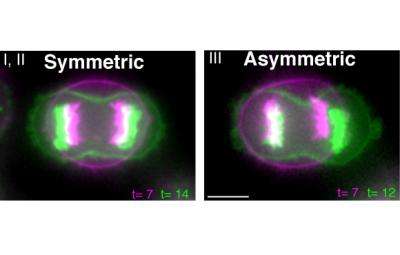Bearing witness to the phenomenon of symmetric cell division

Writing in his journal about the scientists of his era, Henry David Thoreau bemoaned their blindness to significant phenomena: "The question is not what you look at, but what you see." More than 150 years later, his words still ring true.
For more than a century, scientists have been peering through microscopes, carefully watching cells divide. Until now, however, none has actually seen how human cells manage to divide into two equally-sized daughter cells during mitosis.
"This is so obvious when you look at it, but no one ever noticed it," says Whitehead Institute Member Iain Cheeseman, referring to the work of postdoctoral researcher Tomomi Kiyomitsu. "With careful, visual inspection of dividing cells, you see this observation screaming out at you, but no one ever noticed it was there."
Earlier this year, Kiyomitsu, working in Cheeseman's lab, saw that during the metaphase cell cycle step a dividing cell uses the motor protein dynein and two signals to perfectly align the cell's mitotic spindle structure in the middle of the cell. The mitotic spindle is composed of thread-like proteins, called microtubules, which extend from one of two spindle poles on either side of the cell to the duplicated chromosomes in the cell's center. Other microtubules connecting the spindle poles to the cortex—a protein layer lining the cell's outer membrane—act to pull the spindle poles back and forth within the cell until the spindle and chromosomes align down the center axis of the cell.
Kiyomitsu's latest work focuses on the next step of mitosis, called anaphase, when the microtubules tear the paired chromosomes apart so that one copy of each chromosome ends up in each of the new daughter cells. His findings are published in this week's issue of the journal Cell.
When cells enter the final stage of cell division, the point where the cell membrane pinches together depends on the position of the mitotic spindle. If the position is in the middle of the cell, the cells divide symmetrically. All human cell lines growing in tissue culture dishes, and about 95% of cells in a human being, split evenly, resulting in daughter cells of equal size. If the spindle is off-center, the daughter cells will be sized differently. Although unequal division occurs among stem cells—allowing one daughter cell to remain a stem cell while the other matures into another cell type, such as a skin or muscle cell— the goal of a normal symmetric cell division is to generate identical daughter cells and increase cell number. An asymmetric cell division in non-stem cells can instead result in two daughter cells with very different fates, such as one large cell that reinitiates cell division prematurely and a much smaller cell that either grows very slowly or dies.
In approximately 43% of the dividing human cells Kiyomitsu observed, the middle of the mitotic spindle was properly centered at the beginning of anaphase. In about 31% of the cells, the protein motor dynein pulled an off-center spindle toward the middle of the cell during anaphase, correcting its position. Importantly, this ability of dynein to drive these movements required a new plasma membrane targeting mechanism in addition to the ones that Kiyomitsu and others had previously witnessed during metaphase.
Despite this hard work from dynein, in roughly one-quarter of the cells observed, the spindle was misaligned, even after the paired chromosomes were pulled to opposite sides of the cell in late anaphase. Surprisingly, as Kiyomitsu watched these cells divide further, he noticed that they were able to correct this problem by adjusting their cell membranes relative to the spindle, instead of shifting their spindles within the cell.
Mitotic cells growing in a dish are normally plump and round. However, as they complete the division process, they flatten, and the cell membranes extend evenly on both sides to accommodate spindle elongation. But in the misaligned cells, Kiyomitsu observed that the cell membrane extends only on the side closest to the spindle, thereby centering the spindle.
According to Cheeseman, this phenomenon takes place in virtually every plate of dividing human cells, yet no one else has taken note that in a quarter of those cells, the cell membrane grows only to one side in order to correct a potentially disastrous situation. Together, the dynein motor and the controlled cell extension allow the cell to precisely center its spindle for an even division every time.
For the future, Kiyomitsu is interested in focusing on those few cells that do not divide symmetrically.
"I'd like to see what's different in asymmetric cell division," he says. "This process contributes to about 200 different cell types in humans and other mammals, but analyzing them will be difficult, because they will need to be studied in a tissue."
Journal information: Cell
Provided by Whitehead Institute for Biomedical Research



















